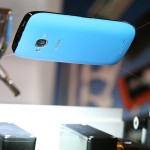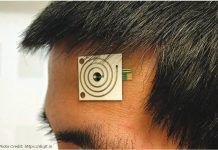
 What happens when a drop of water falls on a lotus leaf? It’s not a philosophical question, but a natural phenomenon scientists have been studying, and trying to make sense of, for hundreds of years.
What happens when a drop of water falls on a lotus leaf? It’s not a philosophical question, but a natural phenomenon scientists have been studying, and trying to make sense of, for hundreds of years.
The drop of water falls, bounces, and rolls away without trace – leaving the leaf clean and water repellant. Now scientists at the Nokia Research Center in Cambridge believe they may be able to replicate the same effect on your phone, using nanotechnology.
Chris Bower, the Principal Scientist at the NRC in Cambridge, sums it up: “Like many scientists we are trying to copy what nature has been doing perfectly for thousands of years.”
To achieve the water-resistant, and stain-resistant, qualities of a lotus leaf the team at NRC is in the final stages of designing a Superhydrophobic coating which would be applied to the outside of a mobile phone.
If you’ve ever used a Teflon non-stick frying pan you’ll be familiar with ordinary hydrophobic coatings already available– but Superhydrophobic coatings add a nanostructure to trap a layer of air over the surface which ensures that a drop of water never reaches it.
Chris Bower produces two hand-held Nokia maze tiles to demonstrate the difference. First he drops water on a surface that has no coating at all: “The water spreads, like this, and coats the surface,” he says.
Then Bower makes a drop of water fall on the maze with the ordinary hydrophobic coating. As predicted, the water holds its form, and you can guide it – a bit uncertainly – around the maze.
Trying the maze with the Superhydrophobic coating makes a dramatic difference: the water drops and almost bounces up again, beading tightly together – and then almost skids over the surface.
Bower explains: “A hydrophobic coating – like Teflon – has a low surface energy and a high contact angle of 120 deg, which makes water form discrete droplets on the surface.”
He goes on to explain that Superhydrophobic coatings have a contact angle that can approach 180 degrees – and the liquid forms discrete drops that literally bounce off the surface:
“The difference is the nano-structured coating, trapping air at the interface, that makes sure the liquid never actually touches the surface.”
Making the nano-coating can be done in a variety of ways: “There are very thin nano-coatings which essentially just deposit a layer of molecules, or more conventional coatings of fluoropolymers or silicones which can be several micrometers thick. It could be deposited from a solution, spray coated, or dip coated.”
The Team at the NRC in Cambridge have set up a demonstration of a Nokia Lumia 710 which has been treated with a Superhydrophobic coating made in their labs.
The water drops onto the Superhydrophobic coated Lumia710, bounces, and rolls off – falling onto a thin layer of Graphene beneath that has also been treated with a Superhydrophobic coating.
In this case the Graphene layer is acting as a sensor which detects the water drop and triggers a high speed camera to capture slow-motion movies so you can see the droplet bouncing off a Superhydrophobic surface.
Bower estimates that Graphene is likely to have a significant impact on mobile devices:
“Graphene is the ultimate surface, it has no bulk so it is very sensitive. Its the strongest known material, its the hardest known material, it has electric performance 100 times better than silicon.”
Graphene is already being used in anti-static coatings, and Bower says it will probably be used as a direct replacement for the transparent conductor Indium Tin Oxide in display screens.
So what can a Superhydrophobic coating on your phone actually do?
Bower can’t guarantee that you can take your mobile diving in deeps seas and it will emerge unscathed – the holes and lines in a mobile phone make it hard to guarantee it could ever be completely waterproof.
But a Superhydrophobic coating makes it likely that you can drop your phone in a bowl of water, or in a cup of coffee, and it will survive.
“It will improve the water resistance, fingerprint resistance and antireflection properties of the device.”
Although the technology is in place to coat the inside of a phone already, Bower says that it is much more difficult to create a coating that is strong enough to use as an external coating:
“The biggest challenge is making nanostructures robust enough to withstand every day wear and tear. You could put a superhydrophobic coating inside a device now because people can’t degrade it, it can’t get knocked around in your pocket. To put it on the outside is much, much tougher. But you want it on the outside because that’s where you see the effects of keeping your phone really clean.”
The team at the Nokia NRC in Cambridge are “pretty close”, he says, to perfecting a robust exterior Superhydrophobic coating.
Superhydrophobia is only one part of building a new form of phones. At the Cambridge NRC the team are working on using nanotechnology to make phones that not only survive being immersed in liquids, but that can also stretch, bend and flex:
“We’re creating a new kind of interactivity, Bower says, “A whole new haptic language for how you use your phone.”
Even so, Bower adds, nature still triumphs. No one has yet created a Superhydrophobic coating that can repair itself, like a lotus leaf. That’s the challenge that still lies ahead.
Conversations by Nokia



